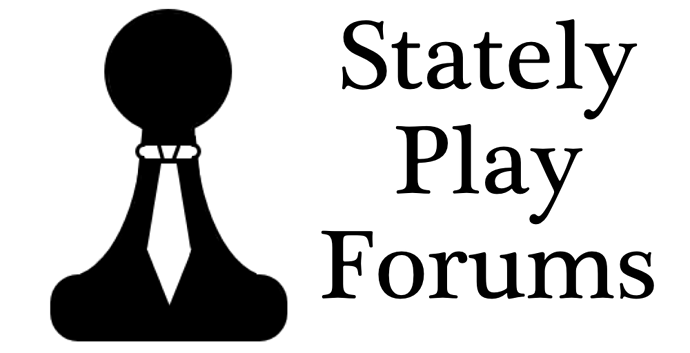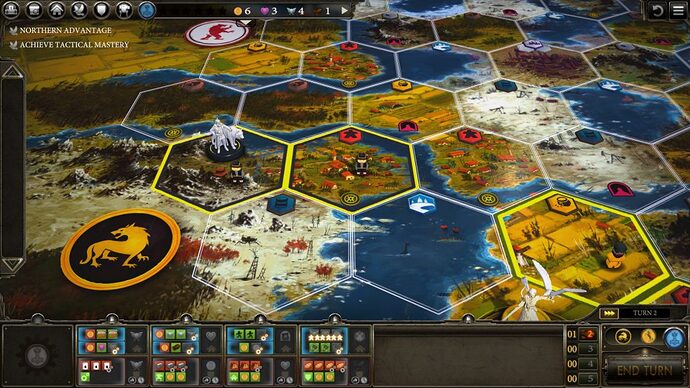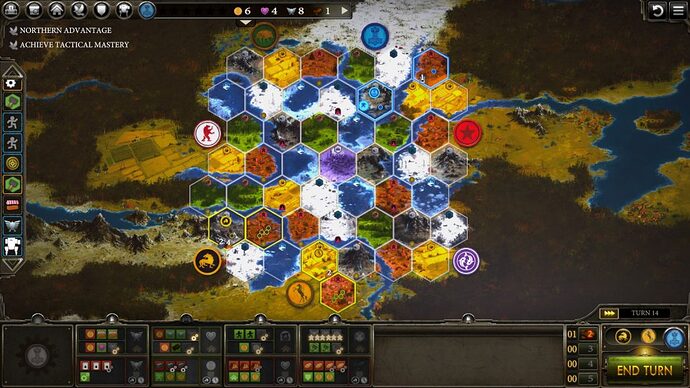Originally published at: http://statelyplay.com/2018/06/21/preview-scythe-digital-edition/
PC •
In 2016, Stonemaier Games released the engine building mech/farming crossover board game Scythe to much acclaim. The game quickly shot up the ranks on BoardGameGeek and currently sits firmly at number seven, ahead of classics like Agricola and Puerto Rico. That’s in no small part to its worldbuilding --a post WWI fought with giant mechs-- along with the addition of strategic 4x gameplay and Jakub Rozalski’s outstanding art. For those reasons, Scythe: Digital Edition, developed by The Knights of Unity and published by [our dark overlords -ed.] Asmodee Digital, is one of the most anticipated titles of 2018. Recently it landed in Early Access which seemed like a good time for us to attempt the conquest of Eastern Europe.
Before we crawl into what makes Scythe such a promising digital tabletop game, I have an admission to make: the board games I have experience with are all on the lighter side (Dominion, Lost Cites, and Ticket to Ride are my favorites) [18xx is next…we’ll break you -ed.]. I want to focus on Scythe from the point of view of someone relatively new to the game, and the medium in general, while still presenting an idea of how well Scythe plays as a video game.
Polished Presentation
Scythe: Digital Edition looks and sounds great for something only just released in Early Access. Asmodee has somehow made a 2D hexmap board game feel like a living, breathing world. Everything looks wonderfully drawn, from the tile art down to the surroundings of the “board.” Rozalski’s art is naturally the focus of much of the game, and it does its job of heightening the overall experience. Factions in the game become more than a couple minis when framed by a stunning piece of art and a bit of backstory.
As someone unfamiliar with the original board game, it can be frustrating to be thrown straight into a screen full of icons and, yet, that’s where Scythe drops you. There’s almost no text to be found. This is a minor complaint, however, as it soon becomes apparent that screen space would be cluttered if they tried to go in another direction, not to mention that hovering over icons reminds the player of what the picture represents.
[caption id=“attachment_5178” align=“aligncenter” width=“1024”]
My god…it’s full of hexes…[/caption]There exists a large portion of video games – especially digital board games – with unremarkable soundtracks. Scythe: Digital Edition’s soundtrack is a delightful surprise in this regard. The music on the title screen invokes the world, bringing to mind images of the lifestyle of the 1920s when people were still very much focused on agricultural pursuits [so, it’s farming music? I’m intrigued -ed.].
Beginner’s Luck?
Scythe has a short, 2-minute gameplay tutorial for the different mechanisms in the game. As a completely new resident of Eastern Europa, it’s a difficult way to learn things. While the game does a good job at explaining these different mechanics, it is not quite obvious how things all come together in a game where your early choices can determine your ultimate fate. I’d love to see these tutorials integrated into the game should the player choose to enable the option. As it currently sits, I’d recommend checking out some gameplay videos on YouTube or reading the rulebook before you dive in.
Scythe revolves around traditional 4x gameplay loops with a twist. Each player can choose from a different “mat” (industrial, engineering, patriotic, mechanical, agricultural) that will determine which actions – two per turn – that they can take in the game. There are two rows of these actions, and the player can pick one from the top and one from the bottom. This can create wildly different experiences depending on the player’s selection.
[caption id=“attachment_5180” align=“aligncenter” width=“1024”]
Damn, I didn’t see this screenshot. Ahem…my god! It’s full of hexes![/caption]Much to my delight, the game ends when six gold stars are collected (I never had enough of those in grade school). These stars are earned by building mechs, upgrading actions, and gaining resources such as popularity or power.
Like many other euro-strategy games, you collect resources and build more workers, units, and structures. But the thing that makes Scythe fun is the manner in which everything is predicated by the limited number of actions you can use per turn. It creates a system in which the player has the agency to make important decisions at many different points in the game. Should I bolster my “Power” resource and prepare for combat, or should I focus on moving workers around, gaining traditional resources like wood and metal, and building structures? Obviously, you have to create a balance to truly succeed.
Each faction, loosely based on Eastern European countries, has its own abilities and bonuses to consider. And if that isn’t enough for you, there also “encounters” in which the player can choose between two different cards that will further impact gameplay and playstyle.
[caption id=“attachment_5181” align=“aligncenter” width=“1024”]
It’s just like Robot Jox![/caption]The number of variables are staggering, but things are not so complex that it is a struggle to see how things connect. I can safely say that each game of Scythe should feel unique.
Early Access?
As someone new to the board game, Scythe: Digital Edition plays like a mostly full experience. There are a few things missing but nothing that the planned 2-4 months of Early Access can’t fix. Currently, there’s no hard level AI but it’s coming with the developers promising to focus on fine tuning the AI before full release. Additionally, there’s currently no option for online multiplayer. The dev has mentioned on Steam that they do plan on implementing both async and sync games in the coming months, which is obviously a welcome feature.
Conclusion
If you’re a fan of digital tabletop games, keep Scythe in mind. Asmodee plans on increasing the price after Early Access, so for $19.99 it’s worth a look (even if mechs and farming in an alternate history 1920’s Europe aren’t your cup of tea).
https://youtu.be/-usrOi_SRK4


